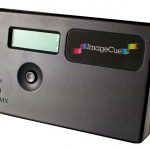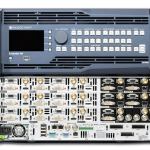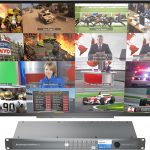New Panels Distributed by SHS Global
There was a time in the not-so-distant past that video walls, let alone “LED” video walls, were a complete luxury reserved only for those with big-enough wallets. I remember (not fondly, mind you) setting up huge rear-projection cube-based cabinets that took up an entire truck for what amounted to a 10-by-14-foot surface. We’d manually tweak the pincushion graph settings (red, green and blue) on each cube until a barely passable picture would emerge on a not-so-bright rear surface that was four feet deep and weighed thousands of pounds. There was one particular time when….oh crap! It was only a dream! Whew….let me wipe the sweat off and get a hold of myself. Lots of Options
Lots of Options
Modular LED panels and video walls are as ubiquitous today as robotic lighting fixtures, maybe more so. They are light, bright, easy to map and most of all — less expensive than their not-too-distant ancestors. Now, to be fair, there are practically as many different flavors of panel as there are manufacturers. Curved, curtain, strips, flex, roll-up- you name it, and there’s an LED solution for it.
I was lucky enough to get my hands on the TourPro Crystal Display 3+ (distributed by SHS Global) recently. It’s a square, 50cm by 50cm panel with built-in rigging frame. I’ve set up all manner of styles and sizes of panel-based systems, and this one was quite distinctive in a couple of key areas. But first….around the unit.
 Around the Panel
Around the Panel
As I mentioned, it’s a square panel, 50cm per side. It weighs in at 8.4kg (18.52 lbs.) — frame, power supply, and all. With a 3.9mm pixel pitch and a greater-than-1,300 candela-per-square-meter level of brightness, it’s no slouch in the image department.
The die-cast aluminum frame is super rigid and lockable on four sides by a rather simple quarter-turn locking handle. Simply line up the panels, insert the keeper and close the lock.
Each frame has large, crescent-shaped handles that are silicon covered and make it extremely easy and comfortable to lift into place by one person. There’s also a swivel metal handle on top for easier transport from case to site.
Once four or more panels are assembled (I had nine for this demo), the corners line up and will accept a four-way style keeper plate that bolts on for extra rigidity, say, in the case of a permanent install.
The power supply is simple and easy to access. Simply push up the pin and unclick it from the back of the panel to replace. There’s a signal go/no go indicator as well as a timer LED on the back. The fly bars have the same quarter-turn swivel lock assembly and line up easily and accurately for attachment to a bar, truss or pipe.
 Cable-Free (Not Wireless)
Cable-Free (Not Wireless)
One of the unique things about this panel is also, hidden in the frame, a cable-free attachment. Notice I said “cable-free” and not “wireless.” Big difference. And while this feature seemed the most intriguing at first, it kind of lost its luster after a while.
There’s a smallish male/female connection point at the top and bottom of each panel that mates up once the turn-lock connectors are engaged. The fact that these connection points are not sealed would make the panel lose its IP 43 rating, but there is a version that will do that in the future.
The panel is certainly capable of a wired connection for data and power using Neutrik twists — in fact, the factory recommends this way for anything except permanent installs. I’d concur. Nothing worse than trying to track down a single small pin that’s gone missing in transit once the wall is assembled.
In truth, the only time wired interconnects are ever a problem are, A) when they are designed as confusingly as possible, or B) when you don’t have enough, or they’re the wrong gender. Or when they are HDMI….but that’s a different argument.
Easy to Rig
As I mentioned earlier, I had nine cabinets shipped to me in a single 1/3 pack case, along with three bumpers, a laptop and a wall controller. In this case, it was a Novastar MCTRL 660. Feel free to choose your own flavor at this point.
I was able to lock together the bumpers and panels within 20 minutes with no documentation or online help for a fine little 150cm2 blinder that lit up the theater nicely.
The powerCON connectors at the top of the bumpers were self-explanatory, as were the single RJ-45 connections. The bumpers serve as hanging points as well as a bottom base if the wall were to be simply sitting in place.
Once the interconnects were complete, I fired up some 4K content and was promptly blown away by the clarity and brightness. With black masking integrated into the honeycomb backing and virtually no ghosting present, the image was quite astounding.
High Refresh Rate
I should mention the average power consumption is 400W per square meter. The big sell for the movie/film crowd, though, is a high refresh rate of ?1000Hz (software adjustable) and a viewing angle of 140° horizontal and 120° vertical. With a spec like this, it looks reeeaalllly good on camera, which is something a lot of my DP/Cinematography friends will appreciate, not to mention the live event/award show folks (and their set designing associates).
These panels are impressive to the human eye as well. I stood further than 140 feet away and could still make a crisp, discernable image. Seams were non-existent. (I guess time will tell whether this holds or not.)
The magnetic panels themselves pop off quite easily with the use of a little SIM-card-like poker tool. They will eventually be fitted with a small butterfly handle to make swapping from behind a breeze.
There are two kinds of panels currently — one is the honeycomb style, which I had. The other is an aluminum board backing for a high dust/high heat environment.
Summing Up
All in all, these TourPro modules are quite capable and impressive. Tool-less assembly, front/back maintenance, lightweight and super-bright. All good things. And for less expense than you might think. I’m thinking the rental market will benefit greatly.
As far as the touring market? Well, I guess you’d need to come up with a way to efficiently transport larger assemblies, like a frame or something, but that’s easily accomplished and something I’m sure SHS will come up with.
@font-face { font-family: “?? ??”; }@font-face { font-family: “Cambria Math”; }@font-face { font-family: “Cambria”; }p.MsoNormal, li.MsoNormal, div.MsoNormal { margin: 0in 0in 0.0001pt; font-size: 12pt; font-family: Cambria; }a:link, span.MsoHyperlink { color: blue; text-decoration: underline; }a:visited, span.MsoHyperlinkFollowed { color: purple; text-decoration: underline; }.MsoChpDefault { font-family: Cambria; }div.WordSection1 { page: WordSection1; }
At a Glance
Bright, Sharp and Easy to Use
The TourPro Crystal Display 3+, distributed by SHS Global, add yet another option to the profusion of LED display options available. Although the module’s cable-free design is a key point of difference in a marketing sense, I didn’t find that to be as important a selling point as the all-around advantages of the panel’s image brightness and quality, high refresh rate and general ease of assembly.
TourPro Crystal Display 3+
PROS: High-resolution, bright, high refresh rate, easy to rig, tool-less assembly
CONS: I can’t afford to line my basement walls with the product
SPECS:
Panel Size: 50 x 50cm
Weight: 18.52 lbs. (including frame & power supply)
Pixel Pitch: 3.9mm
Refresh Rate: ?1000Hz (software adjustable)
Power Consumption: 400W/m²
Price Range: $1,600/tile (base rate, indoor tile); $7,500/m² (w/ bumpers, cases, all cards).
Pricing fluctuates with quantity and quality of product ordered
More Details: Contact distributor SHS Global (www.shsglobal.com)



